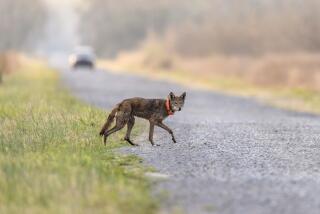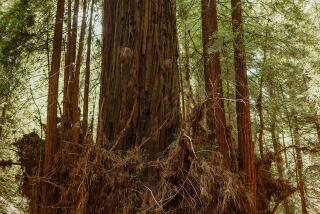Redwoods Offer a Surprising Lesson in the Diversity of Nature
- Share via
In one of Ronald Reagan’s more infamous one-liners, the former president mused that if you’ve seen one redwood tree, you’ve seen them all.
Biologist Chris Brinegar of San Jose State tosses that line out often these days, adding that, “If you’ve seen one president, you’ve seen them all.”
But genetically speaking, there was a time when he was at least partially in agreement with Reagan. Unlike most plant species, redwoods tend to self-reproduce rather than spread through sexual mixing with other trees, so when Brinegar set out on his current research project to gather genetic fingerprints of redwoods, he figured he knew what the results would be.
“I thought I wouldn’t find much diversity,” says the scientist [brinegar@biomail.sjsu.edu]. Only about 1% of the redwoods begin through sexual propagation, Brinegar says, and the rest come either from cones dropped by trees or from stumps of fallen redwoods. That, he thought, would indicate that even entire forests might have begun from a single redwood, so they should be pretty much the same genetically.
But information on that is sparse, so Brinegar set out to collect needles from 20 trees scattered throughout the 450-mile-long redwood forest that stretches from the Big Sur coastline to Oregon. Brinegar packed the needles in dry ice in his backpack to preserve them until he could return to his lab.
Back in San Jose, the scientist flooded each sample with liquid nitrogen, chilling the needles to the point where they could be ground to bits with an old-fashioned mortar and pestle. He then put each sample in an extraction solution, thus freeing the cells of their DNA, in which the genetic makeup of each tree was encoded.
He was surprised to find that the genetic fingerprints of the 20 samples revealed a wide diversity. “So I thought I better go on a more local scale and see how close these trees have to be before they start looking like each other,” he says.
He collected samples from 100 trees in 10 different 1-square-mile areas. He has analyzed only about 30 of those samples, but what he has found has left him a bit astonished.
In one area in the Santa Cruz Mountains, for example, he found that each of the 10 trees was genetically different from the others, although they were all growing within a single square mile.
Brinegar’s research is consistent with the findings of Deborah Rogers, a population geneticist at UC Davis. Rogers studied genetic markers in redwoods in Humboldt State Park for her recent doctoral dissertation.
“My work confirms what he has found,” she says. “The subject has not been widely studied,” she adds, because “the redwood is very difficult to work with. It has three times more genetic material than we find in many other plants and animals.”
Thus, the redwood can “harbor large resident levels of genetic variation,” Rogers says.
That potential may equip the redwood with an extraordinary ability to adapt to changing conditions, she adds.
Biologists believe that genetic diversity within any species improves the chances of survival by giving each plant more tools to fight off attacks. That diversity is usually achieved through cross-fertilization with other plants.
But with redwoods, “How could a tree that very seldom sexually propagates have enough genetic diversity to fight off insects that are constantly changing?” Brinegar asks. It may be, he suggests, that redwoods gain the needed diversity through genetic mutations. Perhaps the redwood, drawing on its vast storehouse of genetic material, simply changes its DNA to help fight off the millions of different kinds of insects it will encounter during its long lifetime.
Brinegar says that is only speculation, but he believes he has discovered something that may be of immense help to both forest ecologists and the lumber industry. Genetic fingerprinting may, for example, help foresters determine which seedlings will do best in any given environment.
Some redwoods may be more tolerant of heat than others; some may be less inclined to spiral as they grow, and thus less likely to produce twisted timbers; some may be more disease-resistant than others. Through genetic fingerprinting, he says, foresters may not have to wait 20 years to see if a seedling is going to produce the kind of tree they are seeking.
The research has also left Brinegar with a message.
“Never underestimate nature,” he says. “Organisms adapt in ways we probably can’t even imagine.”
He says there is much work to be done, because genetic fingerprinting of plants is more rare than of animals.
He will keep at it, he says, partly because it gives him a good excuse to escape his urban lab and walk among the great trees. “To elevate your spirit every once in awhile, there’s just no better way than going out into these forests,” he says.
*
Lee Dye can be reached via e-mail at 72040.3515@compuserve.com
More to Read
Sign up for Essential California
The most important California stories and recommendations in your inbox every morning.
You may occasionally receive promotional content from the Los Angeles Times.













